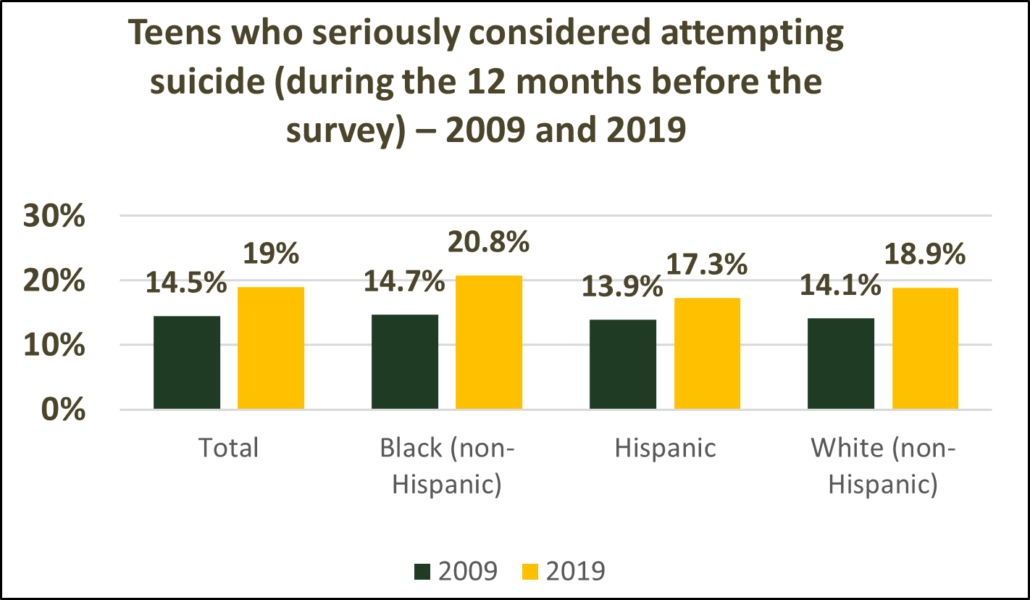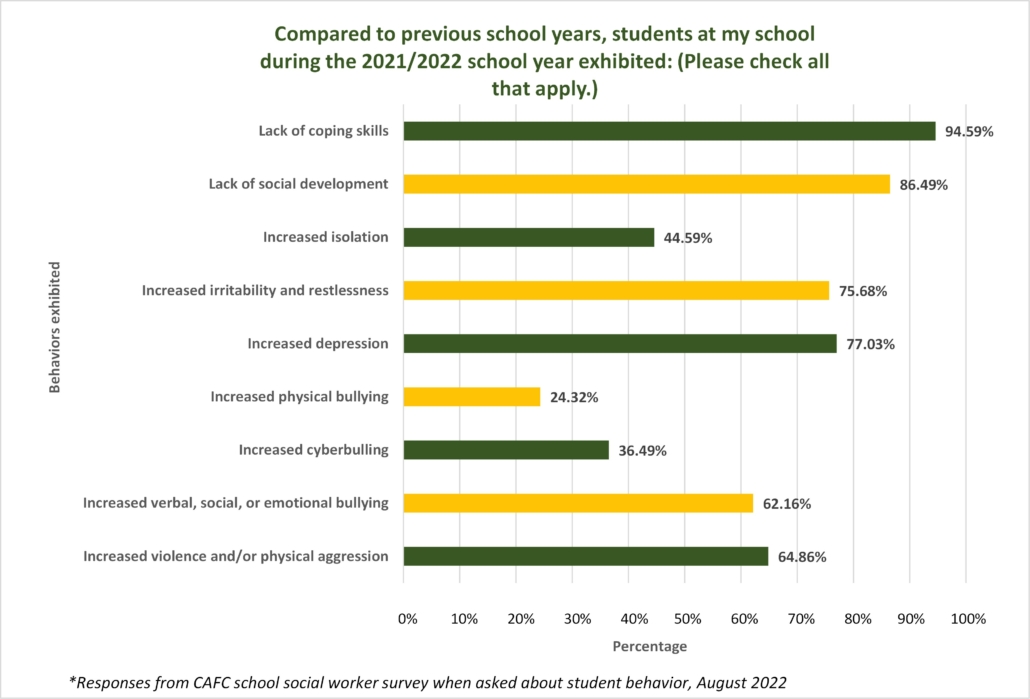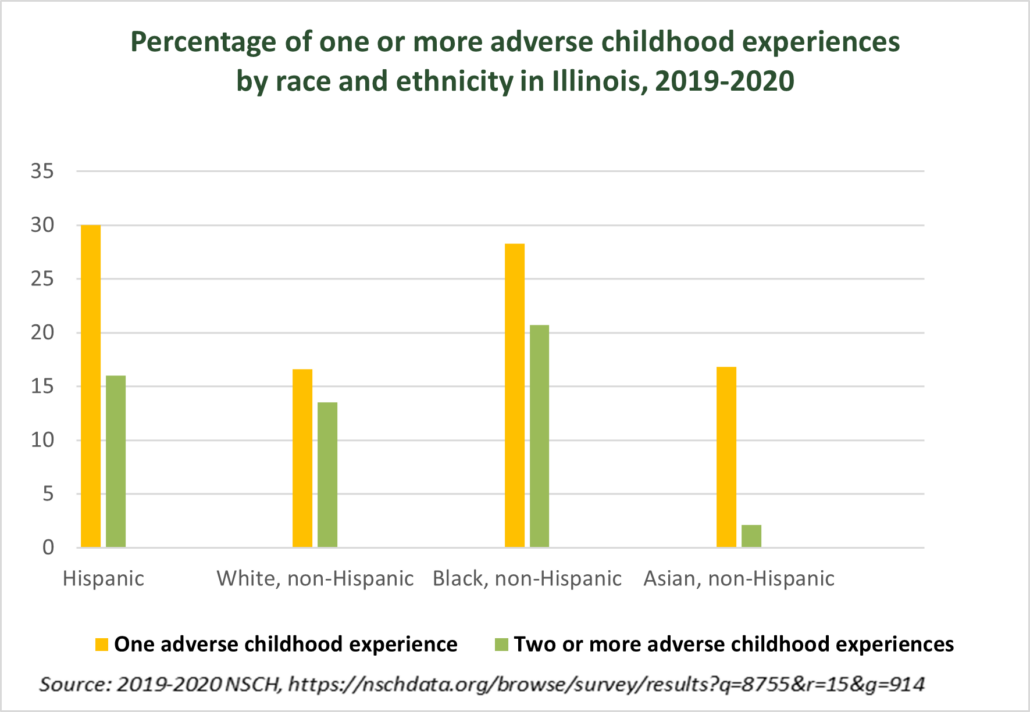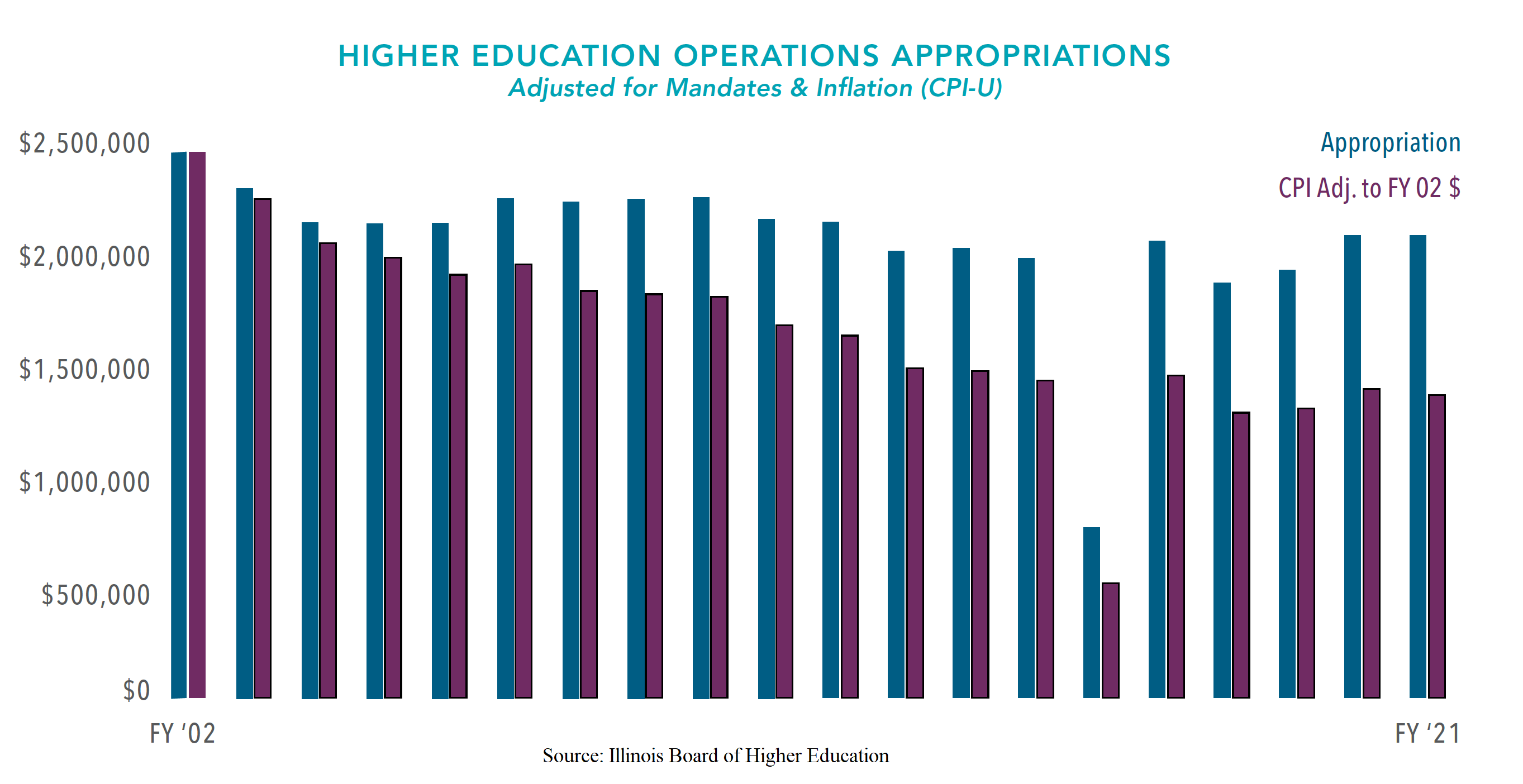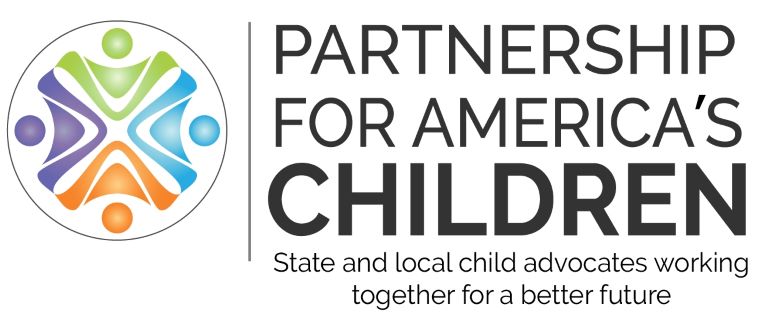Governor J.B. Pritzker presented his proposed Fiscal Year 2024 (FY24) budget to the Illinois General Assembly with an emphasis on education and measures to address a state workforce shortage.
The proposed budget of $49.6 billion in General Revenue Funds (GRF) is slightly lower than anticipated FY23 expenditures once supplemental appropriations for the year are included[i]. The FY24 introduced budget also includes for FY23 a proposed $490 million in GRF supplemental appropriations, an additional $200 million transfer to state pension funds, and a supplemental appropriation of $100 million for Early Childhood Capital Projects.
Because some FY24 anticipated expenditures are for FY23 outstanding bills (and some FY24 bills are expected to carry over to FY25), the net FY24 operating General Revenue Funds operating appropriations total $48.3 billion. The largest categories are:
- 26.5% for education
- 20.5% for human services
- 20.4% for pensions and
- 18.8% for health care.
The remaining 13.8% is allocated for other expenditures GRF which includes public safety, economic development, environment and culture, and other government services (such as employee group health insurance). When including designated federal funds and non-state GRF funds, health care makes up the largest proportion of state state expenditures at 31.3% followed by education at 18.5%.
In addition, to the proposed FY24 expenditures noted above, the state is looking at a transfer of $138 million to the Budget Stabilization Fund[ii].
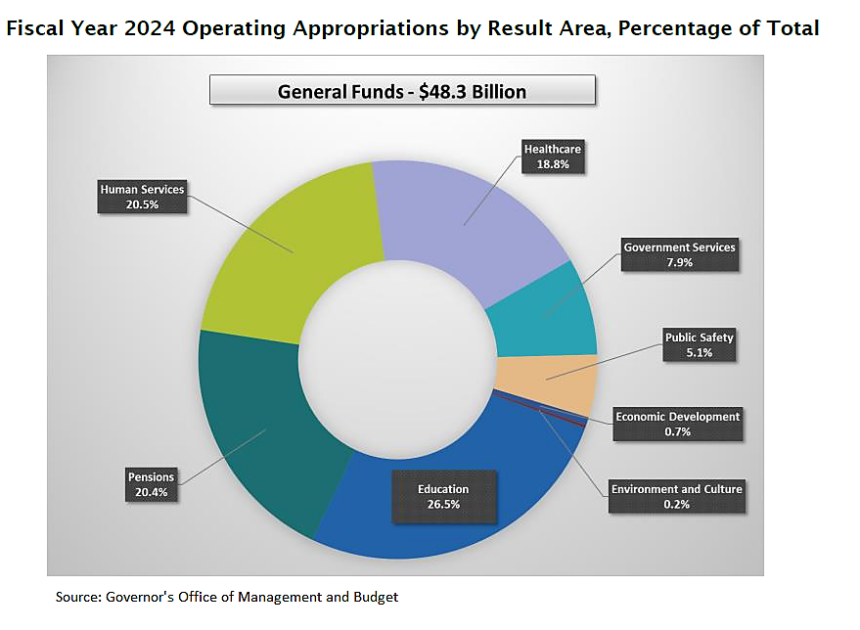
Revenue
In the past two years, the state saw a large influx of revenue from direct federal state payments and grants of COVID-19 relief funds as well as increases in income tax revenue due partly to federal pandemic relief funds made directly to individuals.
The Governor’s Office of Management and Budget (GOMB) estimates base revenues and transfers from other state funds for FY24 to total $49.9 billion for FY24. That is a decrease of $652 million from the projected final FY23 revenues which were, since passage of the initial FY23 budget, significantly revised upward by more than $4.9 billion. That revision was due to, in part, to better-than-expected sales and income tax revenues, a larger than anticipated transfer from the Income Tax Refund Fund to the General Revenue Fund, and increased federal funding (largely a transfer into the General Revenue Fund of federal COVID-19 relief funds received by the state).
Looking at the FY24 projected revenues, part of the revenue calculation involves an increased annual transfer of motor fuel tax revenue into the state’s Road Fund (as required under state law), the fact that in FY23 there was a one-year suspension of the 1% sales tax on groceries (which will be reinstated for FY24), the first repayment to the General Revenue Fund from the state’s Unemployment Insurance Trust Fund of a portion of the state’s FY23 $450 loan the UI Trust Fund, and the anticipation of a mild recession during 2023.
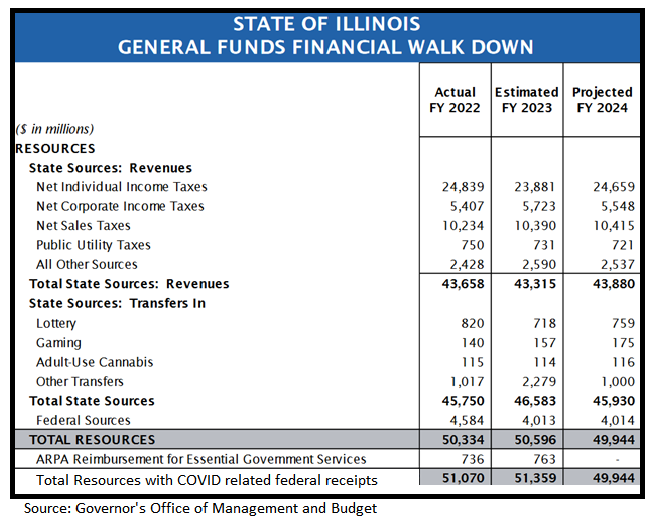
Expenditures
FY23 estimated expenditures have a number of one-time appropriations and transfers. This includes transfers of just under $1.2 billion to the Budget Stabilization Fund and $1.8 billion to the Unemployment Insurance Trust Fund and appropriations for a number of COVID-19 relief measures. During FY23, the state also transferred $200 million above the required certified amounts into the state pension funds and appropriated $400 million to the Large Business Attraction Fund, which state statute outlines partly as a “fund designed to finance large firms considering the location of a proposed plant in the state” (30 ILCS 750/10-6). In addition to the noted expenditures, there was approximately $1.16 billion in income tax and property tax rebate checks approved in the spring of 2022 that were sent to Illinois residents with the expenditures charged to FY22. The state lists another $50 million in tax rebate checks under FY23 expenditures.
A portion of that increase seen in FY23 GRF expenditures is now being replaced by Medicaid GRF cost increases and increased education funding. In addition to examining those areas, this blog posts reviews some of the programs and services impacting children and their families.
Department of Healthcare and Family Services
Medicaid is a federally authorized program providing health care coverage to low-income adults, children, pregnant women, and elderly people with disabilities[iii]. It is authorized by the federal government, jointly funded by states and the federal government, and to a large degree run by states. The federal government matches an amount of state funds spent on Medicaid services and programs. Currently, Medicaid covers approximately 3.9 million Illinois residents or about 30% of the state’s population. Prior to the pandemic, Medicaid covered approximately 2.9 million residents.
The Federal Medical Assistance Percentage (FMAP) is based on a formula that considers state per capital incomes. Under federal law, while a federal declaration of a public health emergency existed (that declaration ends on May 11th), the state received an enhanced matching Medicaid funding of 6.2%. Beginning later this year, the federal government will begin to phase-out the enhanced percentage. Consequently, the Department of Healthcare and Family Services budget calls for a $709 million GRF increase to deal with the enhanced FMAP phase-out.
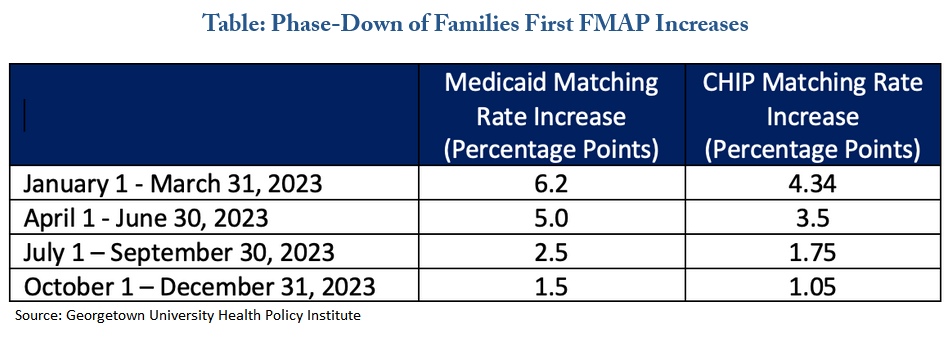
As part of the measures for additional Medicaid funding to a state during the pandemic, Congress required “continuous coverage”. This required Medicaid enrollees would not lose coverage during the pandemic unless they moved out of state, requested cancellation, or passed away. Within the budget Congress approved at the end of 2022 was a sunset date of March 31, 2023,for continuous coverage. That does not mean individuals will lose coverage on that date. According to HFS, the first time anyone will get a renewal notice in the mail is the start of May. That will be just for people whose coverage is due for renewal by June 1st. Other enrollees will receive notices one month before their redetermination month. To help residents maintain Medicaid coverage or (if their income has increased since enrollment making them no longer eligible) transition to other health insurance, the budget includes $8 million dollars for a “Ready to Renew Campaign”.
Also, within the HFS budget is $100 million for Medicaid reimbursement rate increases starting January 1st of next year. HFS has indicated it is targeting increases to facilitate health equity with respect to:
- Improved birth outcomes and lowering rates of maternal mortality
- Behavioral health (with a portion of the emphasis on therapy delivered by a state Licensed Practitioner of the Healing Arts at Community Mental Health Centers[iv]), and
- Dental services
The agency is proposing to work with the dental community on a new assessment to allow further dental rate increases and expand access to dental services.
According to the budget, HFS plans to reinvest $450 million over several years to preserve and grow the healthcare workforce. According to GOMB, in the event the state overpays Managed Care Organizations (MCOs) for the actual level of Medicaid services provided to patients, the refunds from the MCOs to HFS would be used for the healthcare workforce investments.
Education
Early childhood
A centerpiece of the Governor’s proposed budget is his “Smart Start Illinois” early childhood initiative. In total, the Governor is proposing in this FY24 budget an additional $250 million (in some instances through the State Board of Education and in others through the Department of Human Services) to:
- Minimize child care deserts
- Raise child care worker wages
- Increase the quality of child care
- Stabilize the state’s early intervention program to ensure children with developmental delays and disabilities receive needed services and
- Sustain and expand the state’s home visiting program to help promote child development and readiness for school, improve maternal and child health, prevent child abuse and neglect, and prevent domestic violence
Specifically, the budget calls for:
- An additional $75 million for the Early Childhood Block Grant Program to create 5,000 new preschool slots in the next year
- An additional $40 million for Early Intervention Programs to handle expected increases in caseloads and provide a 10% wage increase for providers
- An additional $5 million to expand the Home Visiting Program under DHS and
- An investment of $130 million in state funds (with additional federal dollars) to begin funding Childcare Workforce Compensation Contracts. Based on recommendations from the Governor’s Commission on Equitable Early Childhood Education and Care Funding, the contracts are designed to provide a base funding level for child care providers allowing them to increase child care worker salaries and attract others to the field
Within the DHS budget is $20 million to upgrade the state’ s child care payment management system and $50 million to cover an expected increase in children participating in the state’s Childcare Assistance Program as well as rate increases for providers.
The Governor envisions Smart Start Illinois as a multi-year effort that would in each successive year add additional funding for the Early Childhood Block Grant, Early Intervention Rate Increases, Workforce Compensation Contracts, and the Home Visiting Program.
K-12 Education
The K-12 budget increases funding for the state’s evidence-based school funding formula by $350 million (for a total of $8.3 billion). This formula was revised in 2017 with the goal of adding $3.5 billion into state school funding over the next ten years to help reduce inequities in school funding. The budget also includes a $86.4 million increase for mandated categorical special education and transportation grants.
The state has received more than $8 billion in federal COVID-19 relief funds elementary and secondary schools with 90% of the funds designated for districts with the highest low-income populations. To date, it has distributed $4 billion of the amount with an additional $4 billion to be distributed to schools through September of 2024.
According to the Governor’s office, the state has approximately 3,500 unfilled teaching positions across the state. To help address this issue, the FY24 budget includes $70 million to start a three-year pilot program (with the intention of also spending $70 million in both FY25 and FY26) to improve the teacher pipeline. Specifically, the plan calls for allocating 80% of the funds to 170 of the state’s school district experiencing some of the most significant difficulties in attracting and retaining teachers. The proposal calls for flexibility in how districts could spend the funds through measures such as signing bonuses, housing stipends, tuition and assistance, and help with student loans and licensure fees.
Higher Education
Within the proposed FY24 state budget is a $100 million, or 7% increase, for public universities and community colleges.
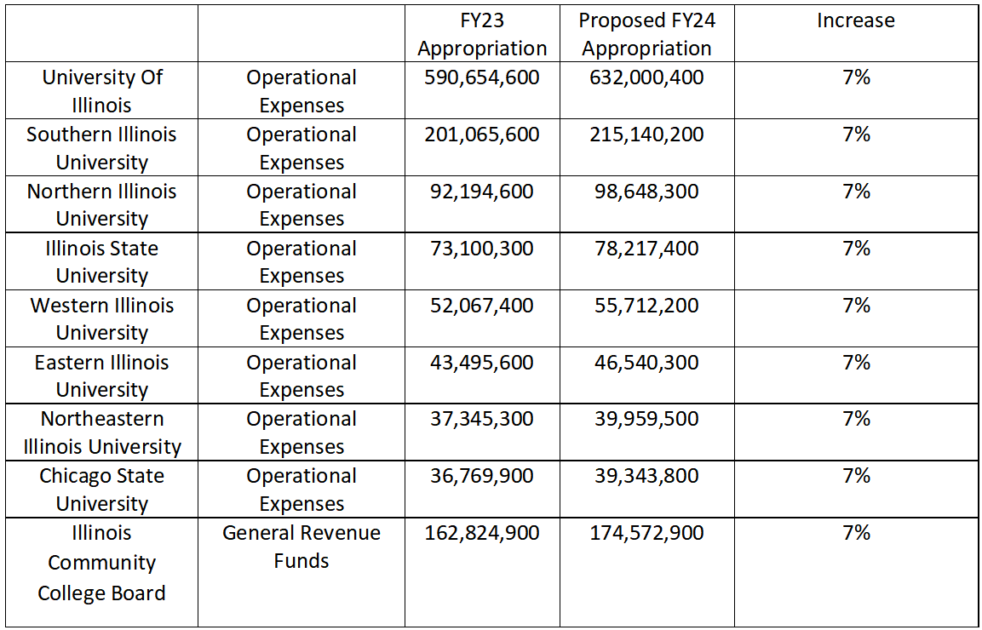
The proposed FY24 budget also includes (within the budget for the Illinois Student Assistance Commission [ISAC]) a $100 million increase for the Monetary Award Program (MAP), which assists Illinois residents with tuition and fees at Illinois colleges and universities (including community colleges). According to the Governor’s office, this will allow nearly all community college students and 40% of public university students at or below median income levels to have their tuition and fees covered through MAP and federal Pell Grants.
The ISAC FY24 budget also includes an additional $2.8 million for the Minority Teachers of Illinois Scholarship Program (bringing the total to $7 million). According to ISAC, the scholarships (which went up to $7,500 in the 2022-23 academic year and can be used for tuition, fees, room and board, or commuter allowances) are for “African American/Black, Hispanic American, Asian American…Native American or…qualified bilingual minority” applicants, planning to “teach at a nonprofit Illinois public, private, or parochial preschool, elementary school, or secondary school, for which the Illinois State Board of Education (ISBE) has determined that no less than 30 percent of the enrolled students are African American/Black, Hispanic American, Asian American, or Native American”.
Department of Children and Family Services
The Department of Children and Family Services (DCFS) general funds line item for personal services and fringe benefits increases by $18.3 million in the proposed FY24 budget. With the funding, the agency is planning on increasing its staffing by 192 people to help address an increasing number of calls to the agency hotline as well as anticipated increases in the number of child abuse and neglect investigations (from an estimated 95,912 in FY23 to an anticipated 97,613 in FY24.)
Including other state and federal funds, DCFS has an overall proposed budget of $2 billion for FY24, which represents an 11% increase from FY23. The overall proposed budget includes $41 million for the rollout of a modernized child welfare information system to replace the previous case management system. The Comprehensive Child Welfare Information System is designed to provide a unified case management system for all DCFS child welfare data and allow for faster case processing. Also within the budget is $30 million for additional Level of Care Support Services to increase the capacity for youth placement in “the most clinically appropriate settings through capital grants and workforce support”[v].
According 2021 news reports, in 343 foster children — some as young as seven — were housed in psychiatric hospitals in 2021 after doctors cleared them for release because DCFS could not find suitable homes for them. [vi]. In 2022, the agency reported the number of youths hospitalized beyond medical necessity was down by 80%[vii].
Department of Human Services
Detailed above in the Smart Start Illinois provisions, was funding set aside for increases in the DHS Home Visiting Program, upgrading the child care payment management system and the Child Care Assistance Program.
TANF
The federal Temporary Assistance for Needy Families (TANF) program provides grant funds to states to assist pregnant women and families with one or more dependent children. TANF funding helps pay for food, shelter, utilities, and expenses other than medical[viii]. (For qualifying families, the benefits can run up to 60 months. Under certain circumstances, an individual may receive TANF benefits for an additional period of time.) The proposed FY24 budget includes an additional $50 million in TANF funding to handle caseload increases and increase the monthly grant payment from 30% of the Federal Poverty Level (FPL) to 40% of FPL. (For an Illinois family of three, the monthly benefit at 30% of FPL in 2022 was just under $550.)
Housing
In 2021, Governor Pritzker issued an executive order to fight homelessness in Illinois. Under the order, he established a State Homeless Chief at DHS to coordinate the state’s efforts to decrease homelessness, improve the health and human service outcomes for people who experience homelessness, and strengthen the safety nets for housing stability.
The proposed FY24 budget establishes under DHS the “Home Illinois” program to target the prevention of homelessness and expand housing supports. In doing so, the Governor switches Illinois Housing Development Authority (IDHA) budget line items from IDHA’s prior fiscal agent (the Department of Revenue) to DHS. The budget calls for a $45 million increase for shelter diversion, emergency and transitional housing, and scattered site supporting housing.
Behavioral Health
In March of 2022, Governor Pritzker established the Children’s Behavioral Health Transformation Initiative with the goal of seeing that young people with significant behavioral health needs receive needed community and residential services. At that time, he appointed Dr. Dana Weiner to head the effort. Dr. Weiner is set to release her report later this month. The DHS proposed FY24 budget includes $1.5 million for the development of a Children’s Behavioral Health Portal. It also increases GRF funding for Comprehensive Community Based Youth Services by $10 million.
A few other programs to note:
- To further help address food insecurity and grocery store deserts in underserved communities, the Department of Commerce and Economic Opportunity (DCEO) proposed FY24 budget includes $20 million for a n Illinois Grocery Initiative to incentivize the opening or expansion of grocery stores by independent grocers or local governments.
- The DCEO budget also includes $10 million for a Clean Energy Career and Technical Education Initiative to assist high schools in developing curricula that supports electric vehicle manufacturing technical education.
- The Department of Public Health’s proposed FY24 budget includes $2 million to support frontline pediatric care providers with the training and resources to provide integrated mental health services and treatment.
In the coming weeks, Children’s Advocates for Change (CAFC) will be taking a closer look at the proposed FY24 budget and following legislative hearings on it. At the same time, CAFC will continue to work for further economic supports for working families with legislative measures establishing a state child tax credit (SB 1444) as well as a state income tax credit for renters (SB 1836, HB 2429). We also hope the final budget will include additional funding for the provision of mental health services to Illinois students.
CAFC also believes that while the Governor notes throughout the proposed FY24 budget education expenditures, community investments, and other grant and loan programs to promote equity, there should be a statement or section in the budget that specifically reviews how the overall proposed expenditures on state programs and services will address outstanding racial and ethic disparities in the state. CAFC will be working with members of the General Assembly this session for passage of HB 3748. The bill requires (starting with the introduction of the FY25 state budget) that the Governor included an explanation within the document of the manner in which provisions of the budget further the Governor’s efforts ensure equity in the State. Such a statement will help focus attention on existing inequities and further the discussion of how to eliminate them.
The Illinois General Assembly has scheduled May 19th as its adjournment date for the spring legislative session.
Written by Mitch Lifson
______________________________________________________________________________________________________
[i] In addition to state general revenue funds there are state special funds (such as revenue collected and specifically designated for health insurance, financial regulation or medical assistance), state highway funds, and federal trust funds.
[ii] The Illinois Budget Stabilization Fund, often called the rainy day fund, is “a special fund in the State treasury established for the purpose of reducing the need for future tax increases, maintaining the highest possible bond rating, reducing the need for short term borrowing, providing available resources to meet State obligations whenever casual deficits or failures in revenue occur, and providing the means of addressing budgetary shortfalls”. (30 ILCS 122/5)
[iii] Definition from Medicaid.gov
[iv] According to the Illinois Administrative Code, a Licensed Practitioner of the Healing Arts is a Illinois licensed healthcare practitioner who, within the scope of State law, has the ability to independently make a clinical assessment, certify a diagnosis and recommend treatment for persons with a mental illness and who is one of the following: a physician; an advanced practice nurse with psychiatric specialty license, a clinical psychologist,
a licensed clinical social worker, a licensed clinical professional counselor, or a licensed marriage and family therapist.
[v] Proposed FY2024 Illinois State Budget”, p. 266
[vi] https://illinoisanswers.org/2022/05/26/foster-children-held-in-jails-shelters-workers-threatened-attacked-a-state-agency-in-crisis/
[vii] ttps://wgntv.com/news/wgn-investigates/dcfs-reports-progress-after-hundreds-of-kids-hospitalized-longer-than-necessary/
[viii] Illinois Department of Human Services



 Children’s Advocates for Change President Dr. Tasha Green Cruzat will moderate a panel discussion on these topics. Panelists include:
Children’s Advocates for Change President Dr. Tasha Green Cruzat will moderate a panel discussion on these topics. Panelists include:
 Kylea Laina Liese, PhD, CNM, of the University of Illinois Chicago whose current research focuses on health system structures and obstetric racism that drive disparities in maternal health and mortality
Kylea Laina Liese, PhD, CNM, of the University of Illinois Chicago whose current research focuses on health system structures and obstetric racism that drive disparities in maternal health and mortality